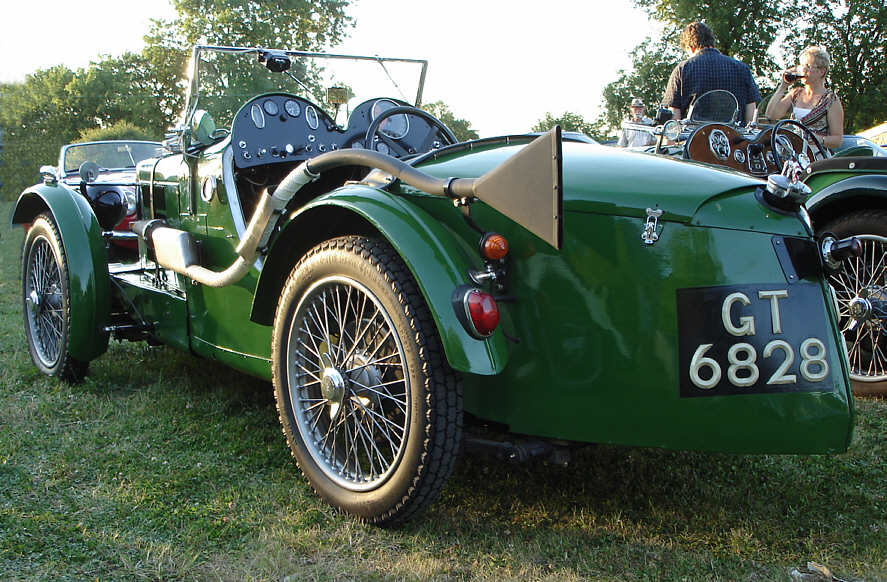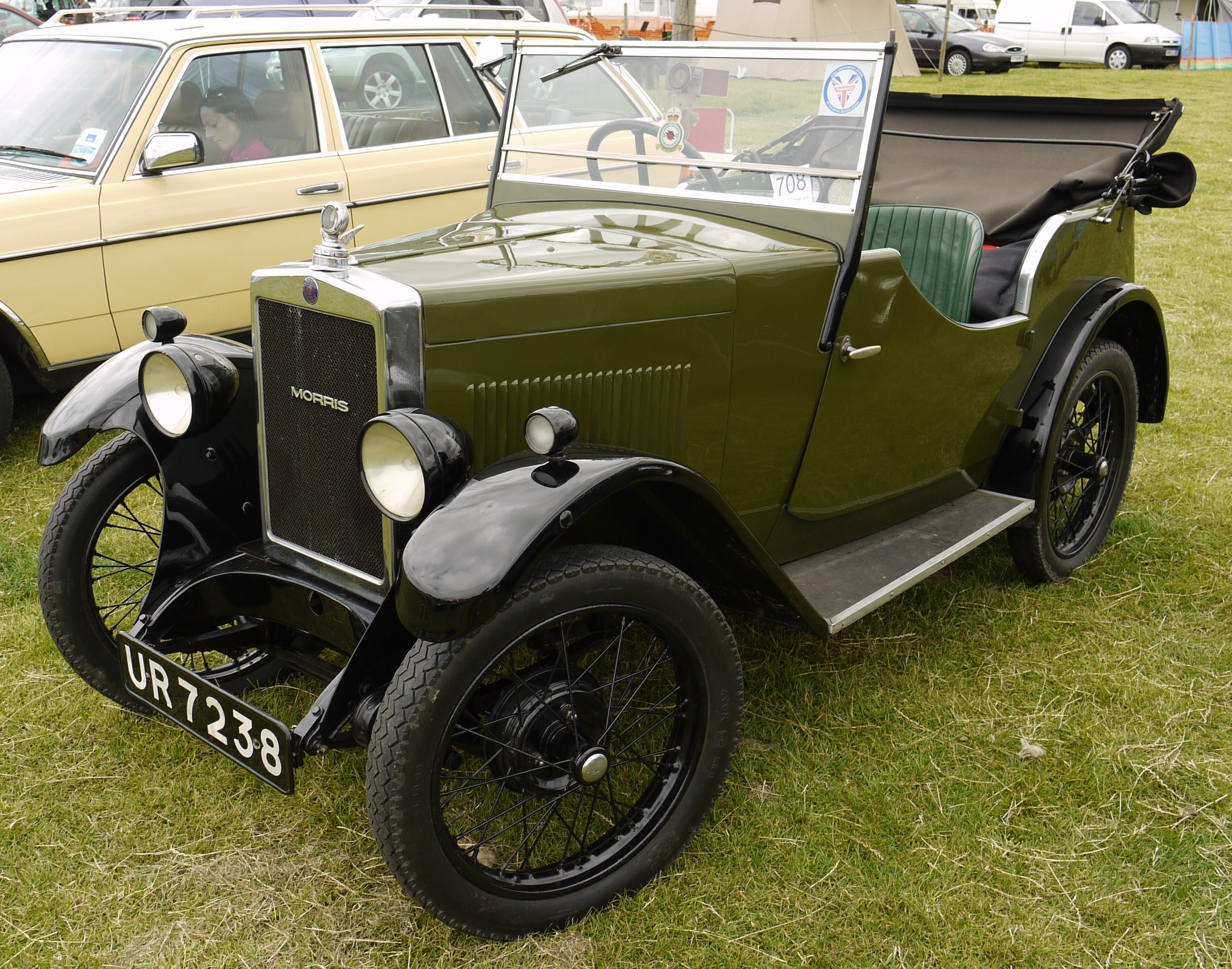|
MG D-type
The MG D-type "Midget" is a sports car that was produced by MG (car), MG in 1931 and 1932. It used the engine from the MG M-type in the chassis from the MG C-type and was only available as a four-seater. Of the 250 cars produced, 208 were open tourers, 37 were salonettes and five went to external coachbuilders. The car used the M-Type 847 cc engine that was derived from the overhead camshaft engine from the 1928 Morris Minor (1928), Morris Minor and Wolseley Motors, Wolseley 10 with a single SU Carburettor producing at 4500 rpm. Drive was to the rear wheels through a three-speed non-synchromesh gearbox with a four-speed gearbox was an option on later cars. The chassis came from the C-Type and took the form of a ladder frame with tubular cross members and passed under the rear axle. The suspension used half-elliptic springs and Hartford friction shock absorbers with rigid front and rear axles and centre lock wire wheels, the brakes were cable operated with ) drums. At ), ) a ... [...More Info...] [...Related Items...] OR: [Wikipedia] [Google] [Baidu] |
MG (car)
MG is a British automotive marque founded by Cecil Kimber in the 1920s, and M.G. Car Company Limited was the British sports car manufacturer existing between 1930 and 1972 that made the marque well known. Since 2007 the marque has been controlled by Chinese state-owned automaker SAIC Motor. MG cars had their roots in a 1920s sales promotion sideline of Morris Garages, a retail sales and service centre in Oxford belonging to William Morris. The business's manager, Cecil Kimber, modified standard production Morris Oxfords and added ''MG Super Sports'' to the plate at the nose of the car. A separate M.G. Car Company Limited was incorporated in July 1930. It remained Morris's personal property until 1 July 1935, when he sold it to his holding company, Morris Motors Limited. MG underwent many changes in ownership over the years. Morris's Nuffield Organization merged with Austin to create the British Motor Corporation Limited (BMC) in 1952. Its activities were renamed MG Divi ... [...More Info...] [...Related Items...] OR: [Wikipedia] [Google] [Baidu] |
MG M-type
The MG M-type (also known as the MG Midget) is a sports car that was produced by MG Cars from April 1929 until 1932. It was sometimes referred to as the 8/33. Launched at the 1928 London Motor Show when sales of larger MG saloons was faltering due to the economic climate, the small car brought MG ownership to a new sector of the market and probably saved the company. Early cars were made in the Cowley factory, but from 1930, production had transferred to Abingdon. Sports car The M-Type was one of the first genuinely affordable sports cars to be offered by an established manufacturer, as opposed to modified versions of factory-built saloon cars and tourers. By offering a car with excellent road manners and an entertaining driving experience at a low price (the new MG cost less than double the cheapest version of the Morris Minor on which it was based) despite relatively low overall performance the M-type set the template for many of the MG products that were to follow, as well ... [...More Info...] [...Related Items...] OR: [Wikipedia] [Google] [Baidu] |
MG J-type
The MG J-type is a sports car that was produced by MG from 1932 to 1934. This 2-door sports car used an updated version of the overhead camshaft, crossflow engine, used in the 1928 Morris Minor and Wolseley 10 and previously fitted in the MG M-type Midget of 1929 to 1932, driving the rear wheels through a four-speed non-synchromesh gearbox. The chassis was from the D-Type with suspension by half-elliptic springs and Hartford friction shock-absorbers all round with rigid front and rear axles. The car had a wheelbase of and a track of . Most cars were open two-seaters, but a closed salonette version of the J1 was also made, and some chassis were supplied to external coachbuilders. The open cars can be distinguished from the M type by having cut-away tops to the doors. __TOC__ J1 The J1 was the four-seat car in the range. The engine was the 847 cc unit previously seen in the C-type with twin SU carburetors giving 36 bhp. The car cost £220 in open and £225 in Sa ... [...More Info...] [...Related Items...] OR: [Wikipedia] [Google] [Baidu] |
Sports Car
A sports car is a type of automobile that is designed with an emphasis on dynamic performance, such as Automobile handling, handling, acceleration, top speed, the thrill of driving, and Auto racing, racing capability. Sports cars originated in Europe in the early 1910s and are currently produced by many manufacturers around the world. Definition Definitions of sports cars often relate to how the car design is optimised for dynamic performance, without any specific minimum requirements; both a Triumph Spitfire and Ferrari 488 Pista can be considered sports cars, despite vastly different levels of performance. Broader definitions of sports cars include cars "in which performance takes precedence over carrying capacity", or that emphasise the "thrill of driving" or are marketed "using the excitement of speed and the glamour of the (race)track" However, other people have more specific definitions, such as "must be a two-seater or a 2+2 seater" or a car with two seats only. In the ... [...More Info...] [...Related Items...] OR: [Wikipedia] [Google] [Baidu] |
FR Layout
A front-engine, rear-wheel-drive layout (FR), also called Système Panhard is a powertrain layout with an engine in front and rear-wheel-drive, connected via a drive shaft. This arrangement, with the engine straddling the front axle, was the traditional automobile layout for most of the pre-1950s automotive mechanical projects. It is also used in trucks, pickups, and high-floor buses and school buses. Front mid-engine, rear-wheel-drive layout A front mid-engine, rear-wheel-drive layout (FMR) places the engine in the front half of the vehicle but ''behind'' the front axle, which likewise drives the rear wheels via a driveshaft. Shifting the engine's center of mass rearward aids in front/rear weight distribution and reduces the moment of inertia, both of which improve a vehicle's car handling, handling. FMR cars are often characterized by a long hood and front wheels that are pushed forward to the corners of the vehicle, close to the front bumper. 2+2 (car body style), 2+2-style ... [...More Info...] [...Related Items...] OR: [Wikipedia] [Google] [Baidu] |
Straight-4
A straight-four engine (also referred to as an inline-four engine) is a four-cylinder piston engine where cylinders are arranged in a line along a common crankshaft. The majority of automotive four-cylinder engines use a straight-four layout (with the exceptions of the flat-four engines produced by Subaru and Porsche) and the layout is also very common in motorcycles and other machinery. Therefore the term "four-cylinder engine" is usually synonymous with straight-four engines. When a straight-four engine is installed at an inclined angle (instead of with the cylinders oriented vertically), it is sometimes called a slant-four. Between 2005 and 2008, the proportion of new vehicles sold in the United States with four-cylinder engines rose from 30% to 47%. By the 2020 model year, the share for light-duty vehicles had risen to 59%. Design A four-stroke straight-four engine always has a cylinder on its power stroke, unlike engines with fewer cylinders where there is no power st ... [...More Info...] [...Related Items...] OR: [Wikipedia] [Google] [Baidu] |
MG C-type
The MG C-type is a sports car that was produced by MG from 1931 to 1932. It was designed for competition use and based on the M-Type Midget. A special car, EX120 had been developed from the M-Type for George Eyston to make an attempt on the 750 cc class 24-hour record at Autodrome de Montlhéry in France. The attempt was successful and a series of replica cars were made which became the C-Type. The car used a tuned short-stroke (73 mm) version of the bevel gear driven overhead camshaft engine from the 1928 Morris Minor and Wolseley 10 with a single SU carburettor and a new crankshaft producing at 6400 rpm. It could from 1932 be had with the crossflow head to be seen later on the MG J-type and a Powerplus supercharger version was also available with at 6500 rpm. Drive was to the rear wheels through a four-speed non-synchromesh gearbox. The chassis was new and took the form of a ladder frame with tubular cross members and passed under the rear axle. The suspension use ... [...More Info...] [...Related Items...] OR: [Wikipedia] [Google] [Baidu] |
Overhead Camshaft
An overhead camshaft (OHC) engine is a piston engine in which the camshaft is located in the cylinder head above the combustion chamber. This contrasts with earlier overhead valve engines (OHV), where the camshaft is located below the combustion chamber in the engine block. ''Single overhead camshaft'' (SOHC) engines have one camshaft per cylinder bank, bank of cylinders. ''Dual overhead camshaft'' (DOHC, also known as "twin-cam") engines have two camshafts per bank. The first production car to use a DOHC engine was built in 1910. Use of DOHC engines slowly increased from the 1940s, leading to many automobiles by the early 2000s using DOHC engines. Design In an OHC engine, the camshaft is located at the top of the engine, above the combustion chamber. This contrasts the earlier overhead valve engine (OHV) and flathead engine configurations, where the camshaft is located down in the engine block. The valves in both OHC and OHV engines are located above the combustion chamber; ... [...More Info...] [...Related Items...] OR: [Wikipedia] [Google] [Baidu] |
Morris Minor (1928)
The Morris Minor is a small 4-seater car with an 850 cc engine (2 variations) manufactured by Morris Motors Limited from 1928 until 1934. The name was resurrected for another newer car for the same market in 1948. History - motivation Beginning in 1922 the tiny seven horsepower Austin had brought motoring to a new public and broadened the market. Against that Morris's Oxfords and Cowleys had taken 41 per cent of the entire 1925 British private car market. Morris sales had begun to slow in 1926. They were revived by a new face for the Morris Oxford and Cowley and an expansion of Morris's range both up and down the scale. The same year William Morris realised millions from the sale and stock market listing of preference shares in his business and he privately bought Wolseley, founded by Herbert Austin, which until a few years earlier had been Britain's largest car manufacturer. William Morris now had ample wherewithal to go after Herbert Austin's little car with his own s ... [...More Info...] [...Related Items...] OR: [Wikipedia] [Google] [Baidu] |
Wolseley Motors
Wolseley Motors Limited was a British motor vehicle manufacturer founded in early 1901 by the Vickers Armaments in conjunction with Herbert Austin. It initially made a full range, topped by large luxury cars, and dominated the market in the Edwardian era. The Vickers brothers diedin 1914 and 1919 respectively and, without their guidance, Wolseley expanded rapidly after the war, manufacturing 12,000 cars in 1921, and remained the biggest motor manufacturer in Britain. Over-expansion led to receivership in 1927 when it was bought from Vickers Limited by William Morris as a personal investment. He moved it into his Morris Motors empire just before the Second World War. After that, Wolseley products were "badge-engineered" Morris cars. Wolseley went with its sister businesses into BMC, BMH and British Leyland, where its name lapsed in 1975. Founding 1901 File:Herbert Austin 1905.jpg, Herbert Austin (1866–1941) in 1905 File:Colonel-thomas-edward-vickers-1896.jp.jpg, C ... [...More Info...] [...Related Items...] OR: [Wikipedia] [Google] [Baidu] |







